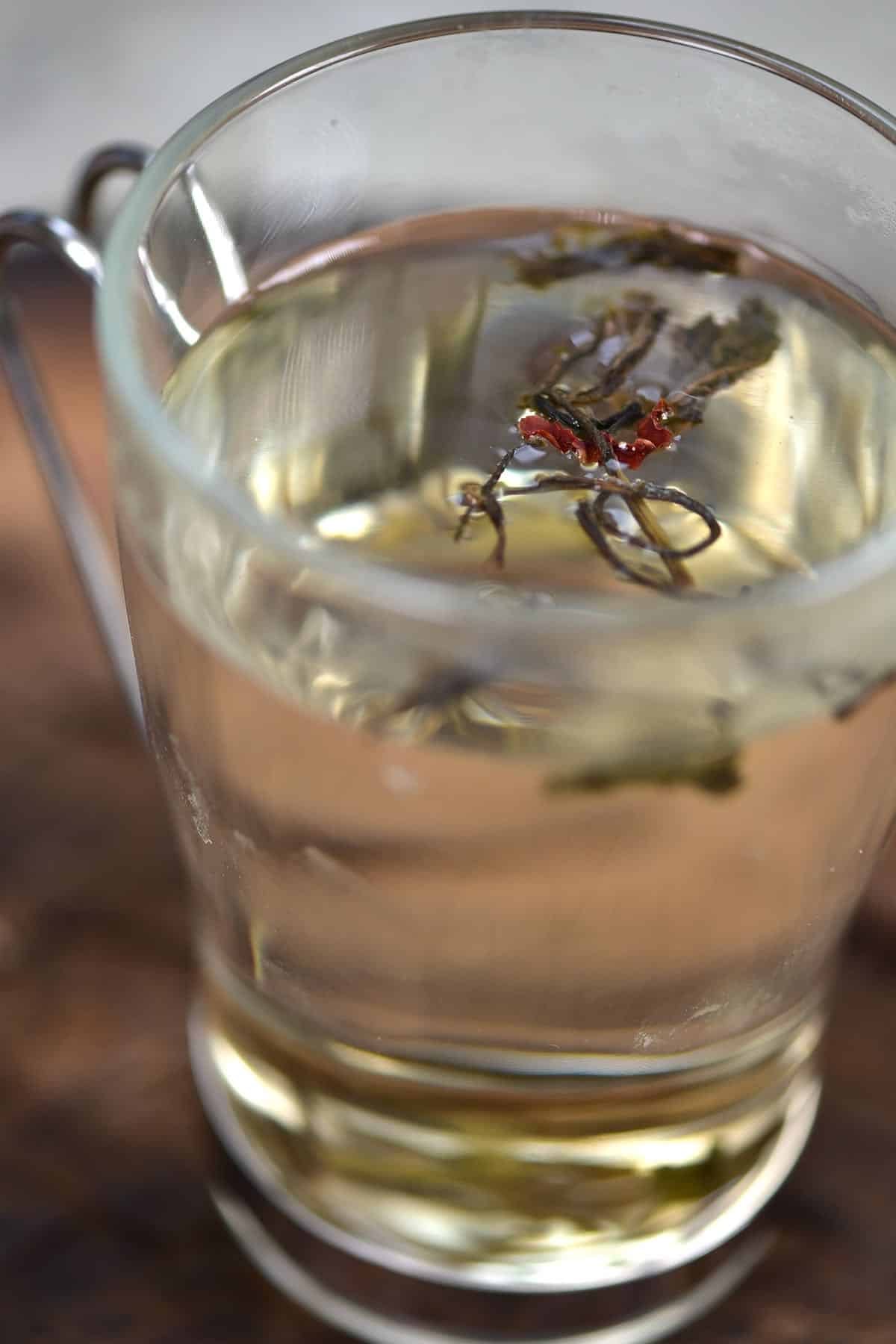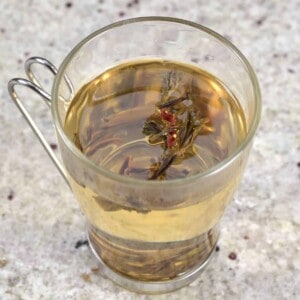This post may contain affiliate links. Please read our disclosure policy.
This is a simple starter guide on how to make green tea (using green tea leaves or teabags), with tips and tricks, FAQs, as well as flavor variations!

As much as I love matcha green tea, loose leaf green tea leaves make for a delicious and warming beverage too – as long as you make it the right way, that is. Unfortunately, unlike many tea options, brewing green tea isn’t quite as simple as chucking the tea/teabag in a mug, covering with boiling water, and sweetening to your desire. Instead, there are some tips on getting the most out of your green tea.
If you don’t prepare green tea the right way, then all you’d end up with is a bitter, grassy beverage. When prepared the right way, though, it’s earthy but flavor-packed and wonderful. Within this post, I’ll take you through how to make green tea, the correct way, as well as FAQs, tips, and flavor variations.

Plus, this post contains the method for brewing loose leaves and tea bags. I prefer to use loose tea when possible. That way you avoid any preservatives and chemicals (from bleaching) that can be present in tea bags. Plus, tea leaves also tend to provide fresher, better flavor.
Want to save this recipe?
FAQs
Short answer – While matcha and green tea both come from the same plant (Camellia sinensis), they are actually grown and prepared differently. You definitely can’t simply grind some green tea leaves to powder and expect it to be the same thing as matcha. Although matcha contains whole ground leaves, it is even more nutritious than standard green tea. Matcha is also with a richer, more full-bodied flavor.
Yes, however, it will vary depending on the type of green tea leaves used and how long it’s brewed for. Plus, it’s usually far less than that of coffee – often 1/3-1/4 of the amount.
Three minutes tends to be ‘the sweet spot’ for green tea before it becomes too bitter. However, I suggest trying the tea after 1 minute of brewing, then every 30 seconds after until you’re happy with the taste.
This can massively vary – as there are so many types of green tea and the taste differs a lot. In general, it has a slightly earthy, grassy flavor. Yet it can also be sweet and even nutty.
As a general rule, I’ve found that 1tsp of leaves per cup works well. However, this can vary depending on the size/shape of the leaves. For example, large leaves will need more – sometimes up to two tablespoons. To give an ‘exact’ amount, 2g leaves to 6oz water works well.

What you’ll need
- Green Tea Leaves – There are several (actually LOTS of!) types of loose green tea leaves, so you can experiment with types and brands to find your preferred product. There are Chinese and Japanese varieties too, so that will also differ in flavor.
- Water – The type of water you use makes a difference. Try to use water that hasn’t been previously boiled. Filtered is also a bonus!
- Sweetener – though optional, I love to add a little maple syrup or honey to my green tea.
- Mug/Teacup – If you’re making a large batch then you can use a teapot or larger jug.
- Tea Strainer/sieve – technically optional, but handy if you don’t like the loose leaves floating in your tea.
- Thermometer – optional. Read the instructions for tips on controlling the water temperature without a thermometer.

The below method also works for green tea teabags too – with the same temperature and steeping time suggestions
How to make green tea
Heat water to 80-85ºC/176-185ºF (not boiling – this is the optimal green tea temperature to avoid a bitter taste). This is best done with a temperature-controlled kettle, however, you can also use a stovetop and thermometer or just heat the water to ‘just before boiling point’, when it simmers, and then allow to cool for a couple of minutes.
Note: If you start to boil the water by mistake, then quickly remove it from the heat and allow it to cool for a few minutes. You can also pour the water into a cool, empty container, and this will help to drop the temperature (if you move it between two containers, it will work even better). You could also add some room temperature water to the boiled water to bring down the temperature.

Pour water in your glass/mug first. Or, if you’re making a large amount, then into the jug/teapot.
Then, add the tea leaves to the water. You can add them directly to the water or use a tea strainer/sieve/infuser.

Note: The leaves can expand and unfold in the water so it’s good to allow plenty of space. For that reason, large infusers are a great option instead of small strainers.
Steep the tea for three minutes. Though, depending on how strong you like your tea, the steeping time will vary. I’d suggest tasting it after 1 minute and every 30 seconds until it’s right for you. If you steep it for too long, then the tea will become bitter/grassy.
Add in the sweetener of your choice or any ‘extras’, and enjoy.
How to flavor green tea
I admit that I find green tea delicious even plain. However, I know that not everyone feels the same way. With that in mind, here are some simple ways to increase the flavor of green tea to your liking.
- Add a small piece of cinnamon
- Add some ginger; fresh ginger, ginger powder, marmalade, or syrup.
- Herbs: mint, peppermint, or chocolate mint all work well. Lemongrass is also a great option.
- Add some organic edible flower petals for extra flavor. Jasmine, lavender, and rose are particularly lovely with green tea.
- You can also add natural essential oils for flavor.
- Use dried fruit as a natural flavor booster and sweetener: mango, peach, pineapple, strawberry, blackberry, etc.
- Citrus peel: Add a slice of lemon or even use lemon, orange, or grapefruit peel – all work well.
- Add Jam – it may sound weird but it’s fruity and sweet and delicious. Like raspberry jam, blackberry jam, strawberry jam, or even rose jam.
Top tips
- To make iced green tea, simply steep the tea as described then allow it to cool and refrigerate. Serve with some lemon juice and ice cubes.
- You can also cold brew this tea (to remove all risk of bitterness). This takes a lot longer than other methods though. You’ll need to leave the tea brewing in cold water in the refrigerator for anywhere between 3-10 hours.
- Whole tea leaves can actually be steeped up to three times, with a slightly different flavor each time.
- Make sure that the tea leaves are still green post-brewing – that’s the sign of authentic green tea.
- Not only do you have the option of loose leaves and tea bags, but there are also green tea-based “flowering teas” that come in the form of little ‘acorn’ looking things (as pictured below) that then open up and bloom in the water while brewing.

More easy drink recipes
- Iced Matcha Latte Recipe
- How To Make Matcha Latte
- How To Make Ginger Tea
- Homemade Tapioca Pearls (Boba)
- Refreshing Blackberry Earl Grey Iced Tea
- Fresh Mint Tea
- How To Make Hibiscus Tea
- How to Make Cinnamon Tea
- British Tea (English Tea | Milk Tea)
- How To Make Turmeric Tea
If you try this green tea recipe, let me know your thoughts and any questions in the comments. Also, feel free to tag me in your recreations @AlphaFoodie.

How to Make Green Tea (With Loose Leaves or Teabags)
Ingredients
- 1 tsp loose tea leaves
- 6 oz water
- sweetener (maple, honey, etc) optional
Instructions
- Heat water to 80-85ºC/176-185ºF* (not boiling – this is the optimal green tea temperature to avoid a bitter taste). This is best done with a temperature-controlled kettle, however, you can also use a stovetop and thermometer or just heat the water to 'just before boiling point'. When it simmers, allow it to cool for a couple of minutes.
- Pour water in your glass/mug first. Or, if you're making a large amount, then into the jug/teapot.
- Then, add the tea leaves to the water. You can add them directly to the water or use a tea strainer/sieve/infuser.**
- Steep the tea for three minutes. Though, depending on how strong you like your tea, the steeping time will vary. I’d suggest tasting it after 1 minute and every 30 seconds until it’s right for you. If you steep it for too long, then the tea will become bitter/grassy.
- Add in the sweetener of your choice or any ‘extras’, and enjoy.
Video
Notes
- To make iced green tea, simply steep the tea as described then allow it to cool and refrigerate. Serve with some lemon juice and ice-cubes.
- You can also cold brew this tea (to remove all risk of bitterness). This takes a lot longer than other methods though. You’ll need to leave the tea brewing in cold water in the refrigerator for anywhere between 3-10 hours.
- Whole tea leaves can actually be steeped up to three times, with a slightly different flavor each time.
- Make sure that the tea leaves are still green post-brewing – that’s the sign of an authentic green tea.
- Not only do you have the option of loose leaves and tea bags, but there are also green tea-based ‘flowering teas‘ that come in the form of little ‘acorn’ shape, that open up and bloom in the water while brewing.
Nutrition
Nutrition information is automatically calculated, so should only be used as an approximation.
















Complicated but simple.
Thank you for your comment!
excellent man great info.. love it
Thank you for your comment, Anamta.
We can go on and on about the benefits of drinking green tea, but here are just a few: research shows that green tea can create a stimulating effect to help keep us energized and focused, without the jittery side effects of coffee or espresso.
Thank you for sharing these, Carolyn.